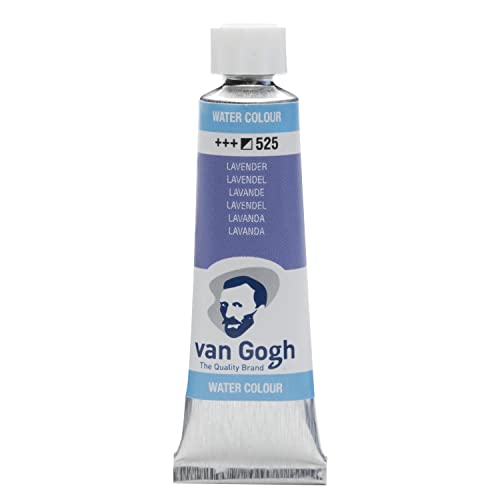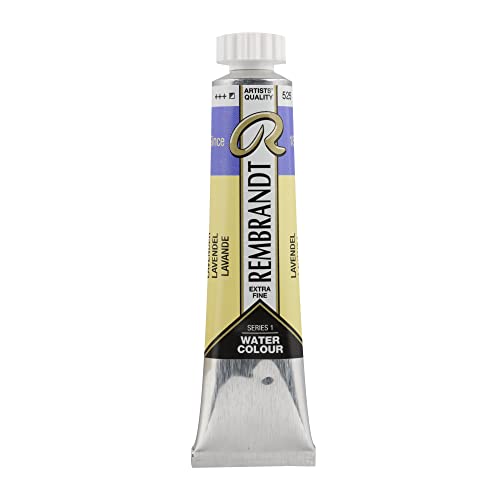
Lavender is a color that combines the strength of purple with the gentleness of blue. In this article, we will learn about the history, composition, and application of Lavender in watercolor art.
| Preview | Product | Rating | Price | |
|---|---|---|---|---|

|
Daniel Smith Extra Fine Watercolor 15ml Paint Tube, Lavender, 0.5 Fl Oz (Pack of 1) | No ratings yet |
$17.00 |
Buy on Amazon |

|
Van Gogh Watercolor Paint, 10ml Tube, Lavender 525 | No ratings yet | $6.55 | Buy on Amazon |

|
Rembrandt Tubo de acuarela 20 ml Lavanda 525 | No ratings yet | Buy on Amazon |
The History of Lavender
The name “Lavender” originates from the lavender flower (lavandula), which grows primarily in the Mediterranean region. It has been widely used in soap making, perfumes, and medicine since ancient times. The color of lavender flowers symbolizes refinement, grace, and elegance
In the 19th century, Lavender began to be noticed by artists, especially in the works of the Impressionist school, when artists began to pay more attention to the use of light and soft colors. During this period, famous artists such as Claude Monet, Vincent van Gogh and Edgar Degas can be mentioned.
Today, Lavender color becomes a popular choice in interior design, fashion and painting.
How to create lavender in watercolor
In watercolor, Lavender is known as a pastel color, usually created by mixing pigments of blue, light red, and white to achieve a soft pastel tone that includes light blue and purple tones. There are various ways to mix Lavender depending on the shade the artist wants:
Ultramarine Blue (PB29)+ Ultramarine Violet(PV15), and Titanium White (PW6): The combination of strong blue pigments and reddish-purple creates a Lavender shade close to the natural lavender flower color. This is also the most common mixing formula used by art supply companies.
Additionally, you can mix other colors of similar hues to create your own lavender color; the result is not significantly different from the usual way.
Cobalt Blue (PB28)+ Quinacridone Violet (PV19) with Titanium White (PW6): Cobalt Blue provides a light, muted blue tone, while Quinacridone Violet adds a pinkish-purple, resulting in a bright and airy Lavender.
Lavender from art supplies suppliers.
In the market, lavender is available in tubes from different watercolor brands. Each brand has slight variations in shades, ranging from light blue to light purple, depending on the formula and ingredients they use.
Some popular brands that offer Lavender include Daniel Smith, Holbein, and Turner. etc.

Daniel Smith’s Lavender is a stunning semi-transparent blue with exquisite granulation and easy liftability. This unique shade is crafted from a blend of three pigments: Titanium White (PW 6), Ultramarine Violet (PV 15), and Ultramarine Blue (PB 29).
Applications of Lavender in Watercolor
Lavender is a versatile color in watercolor with many applications. It can be used in a wide range of artwork, from natural landscapes to flowers and plants. Additionally, it is especially useful for artists who want to create a peaceful, quiet, or dreamy feel in their work.
- Landscape Paintings: Lavender is an excellent choice for backgrounds in paintings of countryside scenes, or settings with a quiet atmosphere. It’s especially fitting for painting skies or winter scenes with snow.

- Lavender also blends smoothly in gradients, creating soft and natural color transitions. This is particularly helpful when painting water, such as rivers, and lakes; or creating the misty effect of fog.
- Flowers and Plants: Lavender is perfect for painting flowers like lavender, lilacs, or other flowers with light purple or blue tones, such as hydrangeas or irises.

Blending Lavender with Other Colors
Lavender can be mixed with many other colors. However, it should mainly be blended with its similar tones ( analogous colors) like blue or purple, if mixed with contrasting colors like yellow or orange it will result in a dull and muddy gray.
Conclusion
In short, with its ability to create a serene, dreamy, and elegant atmosphere, Lavender has become one of the most beloved colors by watercolor artists, especially for painting landscapes, flowers, and plants. This shows that Lavender color has a special appeal in the art world.
